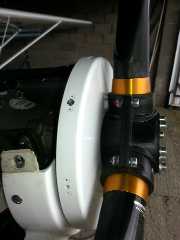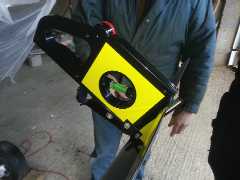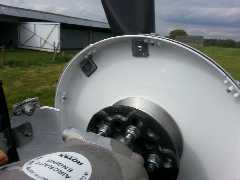G-UFOX
- Propeller (Stuff We Have Learnt)
The spinner backplate/flange needs to
be drilled with the six holes for the prop mounting bolts. These must be aligned
so that the prop blades are aligned with the spinner.
Lay the flange horizontal on a bench with
the prop loose assembled on top. Put the spinner on top and align the notches
of the spinner and its flange. You can then align the prop blades with the apertures
in the spinner by eye. Carefully remove the spinner without disturbing the prop
and then mark the position of the mounting holes onto the flange. You can then
use the aluminium spacer to fine align the holes for drilling.

 Assemble
the prop blades into the hub with the bolts fitted with the heads to the front
and nuts towards the the engine. Ensure you put the main bolts in FIRST in the
same orientation. Each blade must be pulled outwards radially. You don't need
to tighten fully until you adjust the blade pitch. The main bolts have plain
washers between the bolt head and the front of the prop. We did try extra washers
here for balancing, but later used weights on the flange. The special washers
with the radial serrations go between the gearbox flange and the nuts, with
the serrations toward the nuts.
Assemble
the prop blades into the hub with the bolts fitted with the heads to the front
and nuts towards the the engine. Ensure you put the main bolts in FIRST in the
same orientation. Each blade must be pulled outwards radially. You don't need
to tighten fully until you adjust the blade pitch. The main bolts have plain
washers between the bolt head and the front of the prop. We did try extra washers
here for balancing, but later used weights on the flange. The special washers
with the radial serrations go between the gearbox flange and the nuts, with
the serrations toward the nuts.
 The
pitch of the blades is set using a special protractor with a spirit level mounted
in it. Roger has one made by DUC that you may be able to borrow. Use masking
tape and mark the distance from the blade tip (200mm) with a line. Set the plane
attitude so that the prop boss is vertical (or otherwise subtract the angle
from the setting angle). Clamp the gauge onto the back of the blade with the
correct pitch set and check the blade is horizontal. Gently wriggle the blade
around until the bubble is level (you will probably have to loosen the main
bolts to achieve this) and then tighten the bolts. Do all blades and then re-check
them. You can also check the tracking at the same time using a fixed pointer.
Of course, once you have done the static engine speed test, you may need to
change the pitch to get the correct speed. It is apparently about 200rpm per
degree.
The
pitch of the blades is set using a special protractor with a spirit level mounted
in it. Roger has one made by DUC that you may be able to borrow. Use masking
tape and mark the distance from the blade tip (200mm) with a line. Set the plane
attitude so that the prop boss is vertical (or otherwise subtract the angle
from the setting angle). Clamp the gauge onto the back of the blade with the
correct pitch set and check the blade is horizontal. Gently wriggle the blade
around until the bubble is level (you will probably have to loosen the main
bolts to achieve this) and then tighten the bolts. Do all blades and then re-check
them. You can also check the tracking at the same time using a fixed pointer.
Of course, once you have done the static engine speed test, you may need to
change the pitch to get the correct speed. It is apparently about 200rpm per
degree.
 If
you ask Roger very nicely, you may be able to use his prop balancer - it is
the right tool for the job and can balance the prop, spinner, flange and spacer
as a complete unit. The prop assembly gets bolted to the balancers flange. Ensure
that the bearing is horizontal. The bearings are heated with a heat gun to reduce
the grease friction. An electric drill it attached to the mechanisms extra shaft
and will vibrate a bearing and effectively kill the stiction, so that gravity
will pull the heaviest part of the rig downwards. Experiment by starting at
a few different starting positions in case you happen to get the heaviest part
at top dead centre (when it wouldn't move).
If
you ask Roger very nicely, you may be able to use his prop balancer - it is
the right tool for the job and can balance the prop, spinner, flange and spacer
as a complete unit. The prop assembly gets bolted to the balancers flange. Ensure
that the bearing is horizontal. The bearings are heated with a heat gun to reduce
the grease friction. An electric drill it attached to the mechanisms extra shaft
and will vibrate a bearing and effectively kill the stiction, so that gravity
will pull the heaviest part of the rig downwards. Experiment by starting at
a few different starting positions in case you happen to get the heaviest part
at top dead centre (when it wouldn't move).  The
balance can be nulled by attaching some self adhesive weights onto the rear
of the spinner flange. Don't remove the backing tape yet - just stick them on
with masking tape, so that you can move them around until you get them perfect
- it will take several goes. Then drill, stick and pop rivet them into the flange.
It might be worth drilling the weights before you start. It sounds like a faff
but is WELL worth the effort.
The
balance can be nulled by attaching some self adhesive weights onto the rear
of the spinner flange. Don't remove the backing tape yet - just stick them on
with masking tape, so that you can move them around until you get them perfect
- it will take several goes. Then drill, stick and pop rivet them into the flange.
It might be worth drilling the weights before you start. It sounds like a faff
but is WELL worth the effort.
Return to "Stuff
We Have Learnt" page
Return to main index page

 Assemble
the prop blades into the hub with the bolts fitted with the heads to the front
and nuts towards the the engine. Ensure you put the main bolts in FIRST in the
same orientation. Each blade must be pulled outwards radially. You don't need
to tighten fully until you adjust the blade pitch. The main bolts have plain
washers between the bolt head and the front of the prop. We did try extra washers
here for balancing, but later used weights on the flange. The special washers
with the radial serrations go between the gearbox flange and the nuts, with
the serrations toward the nuts.
Assemble
the prop blades into the hub with the bolts fitted with the heads to the front
and nuts towards the the engine. Ensure you put the main bolts in FIRST in the
same orientation. Each blade must be pulled outwards radially. You don't need
to tighten fully until you adjust the blade pitch. The main bolts have plain
washers between the bolt head and the front of the prop. We did try extra washers
here for balancing, but later used weights on the flange. The special washers
with the radial serrations go between the gearbox flange and the nuts, with
the serrations toward the nuts.

